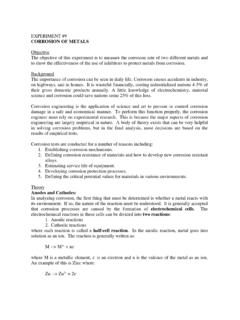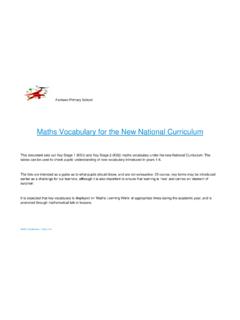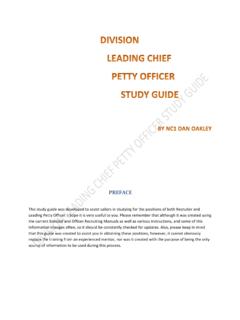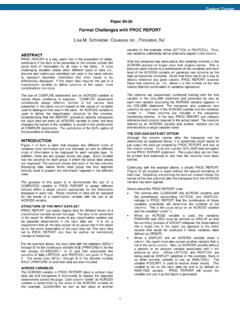Transcription of Spring - ingleton.durham.sch.uk
1 Mastery Overview Year 3/4 Spring Year 3/4. Mixed Year Overview Guidance Since our Year 1 to Year 6 Schemes of Learning and overviews The White Rose Maths Hub has produced these long term plans have been released we have had lots of requests for something to support mixed year groups. The mixed year groups cover similar for mixed year groups. This document provides the Y1/2, Y3/4 and Y5/6. These overviews are designed to support yearly overview that schools have been requesting. We really a mastery approach to teaching and learning and have been hope you find it useful and use it alongside your own planning. designed to support the aims and objectives of the new National Curriculum. We had a lot of people interested in working with us on this project and this document is a summary of their work so far.
2 We The overviews: would like to take this opportunity to thank everyone who has have number at their heart. A large proportion of time is contributed their thoughts to this final document. spent reinforcing number to build competency. ensure teachers stay in the required key stage and These overviews will be accompanied by more detailed support the ideal of depth before breadth. schemes linking to fluency, reasoning and problem solving. provide plenty of time to build reasoning and problem Termly assessments will be available to evaluate where the solving elements into the curriculum children are with their learning. This document fits in with the White Rose Maths Hub Year 1 . If you have any feedback on any of the work that we are doing, 6 Mastery documents.
3 If you have not seen these documents please do not hesitate to get in touch. It is with your help and before you can register to access them for free by completing ideas that the Maths Hubs can make a difference. the form on this link learning-schemes-resources/. The White Rose Maths Hub Team Once registered you will be provided with a Dropbox link to access these documents; please be aware some school IT. systems block the use of Dropbox so you may need to access this at home. Trinity Academy Halifax 2016. Year 3/4. Mixed age planning Using the document Progression documents The overviews provide guidance on the length of time that We are aware that some teachers will teach mixed year should be dedicated to each mathematical concept and the groups that may be arranged differently to our plans.
4 We are order in which we feel they should be delivered. Within the therefore working to create some progression documents that overviews there is a breakdown of objectives for each help teachers to see how objectives link together from Year 1. concept. This clearly highlights the age related expectations to Year 6. for each year group and shows where objectives can be taught together. Linking of objectives There are certain points where objectives are clearly separate. In these cases, classes may need to be taught discretely or Within the overviews, the objectives are either in normal font incorporated through other subjects (see guidance below). or in bold. The objectives that are in normal font are the lower year group out of the two covered (Year 1, Year 3, Year 5).
5 Certain objectives are repeated throughout the year to The objectives in bold are the higher year group out of the two encourage revisiting key concepts and applying them in covered (Year 2, Year 4, Year 6), Where objectives link they different contexts. are placed together. If objectives do not link they are separate and therefore require discrete teaching within year groups. Lesson Plans As a hub, we have collated a variety of lesson plans that show how mixed year classes are taught in different ways. These highlight how mixed year classes use additional support, organise groups and structure their teaching time. All these lesson structures have their own strengths and as a teacher it is important to find a structure that works for your class.
6 Trinity Academy Halifax 2016. Year 3/4. Mixed age planning Teaching through topics Objectives split across topics Most mathematical concepts lend themselves perfectly to Within different year groups, topics have been broken down subjects outside of maths lessons. It is important that teachers and split across different topics so children can apply key skills ensure these links are in place so children deepen their in different ways. understanding and apply maths across the curriculum. Money is one of the topics that is split between other topics. It Here are some examples: is used within addition and subtraction and also fractions. In Year 1 and 2 it is important that the coins are taught discretely Statistics- using graphs in Science, collecting data in however the rest of the objectives can be tied in with other Computing, comparing statistics over time in History, number topics.
7 Drawing graphs to collect weather data in Geography. Roman Numerals- taught through the topic of Romans Other measurement topics are also covered when using the within History four operations so the children can apply their skills. Geometry (shape and symmetry)- using shapes within tessellations when looking at Islamic art ( ), using In Year 5 and 6, ratio has been split across a variety of topics shapes within art (Kandinsky), symmetry within art including shape and fractions. It is important that these Measurement- reading scales (science, design objectives are covered within these other topics as ratio has technology), been removed as a discrete topic. Co-ordinates- using co-ordinates with maps in Geography.
8 Written methods of the four operations- finding the time Times tables difference between years in History, adding or finding the difference of populations in Geography, calculating Times tables have been placed within multiplication and and changing recipes in food technology. division however it is important these are covered over the Direction- Programming in ICT year to help children learn them. Trinity Academy Halifax 2016. Year 3/4. Everyone Can Succeed More Information As a Maths Hub we believe that all students can succeed If you would like more information on Teaching for Mastery'. in mathematics. We don't believe that there are individuals you can contact the White Rose Maths Hub at who can do maths and those that can't.
9 A positive teacher mindset and strong subject knowledge are key to student success in mathematics. We are offering courses on: Bar Modelling Acknowledgements Teaching for Mastery Subject specialism intensive courses become a The White Rose Maths Hub would like to thank the Maths expert. following people for their contributions, and time in the collation of this document: Our monthly newsletter also contains the latest initiatives we are involved with. We are looking to improve maths Cat Beaumont across our area and on a wider scale by working with other Matt Curtis Maths Hubs across the country. James Clegg Becky Gascoigne Sarah Gent Sally Smith Sarah Ward Trinity Academy Halifax 2016. Term by Term Objectives Year 3/4.
10 Year 3/4 Overview Week 1 Week 2 Week 3 Week 4 Week 5 Week 6 Week 7 Week 8 Week 9 Week 10 Week 11 Week 12. Autumn Multiplication Place Value Addition and Subtraction and Division Spring Multiplication and Division Fractions and Decimals Volume and Summer Capacity (Y3). Length and Perimeter Time Shape Statistics Co-ordinates (Y4). Trinity Academy Halifax 2016. Term by Term Objectives Year 3/4. Year Group Y3/4 Term Spring Week 1 Week 2 Week 3 Week 4 Week 5 Week 6 Week 7 Week 8 Week 9 Week 10 Week 11 Week 12. Number: Multiplication and Division Fractions and Decimals Solve problems involving multiplication and division, using materials, Recognise and use fractions as numbers: unit fractions and non-unit fractions with small denominators.





